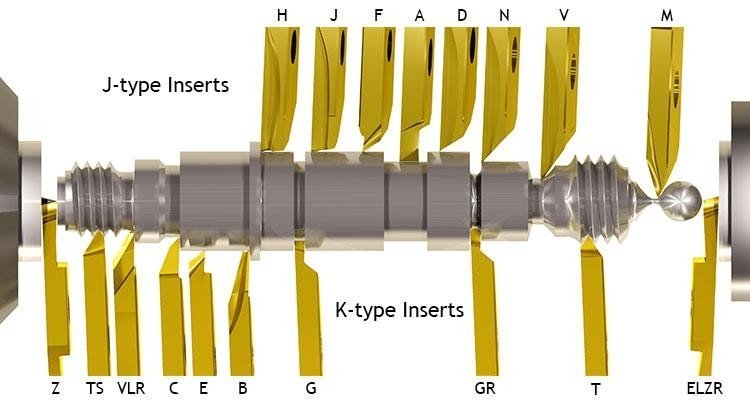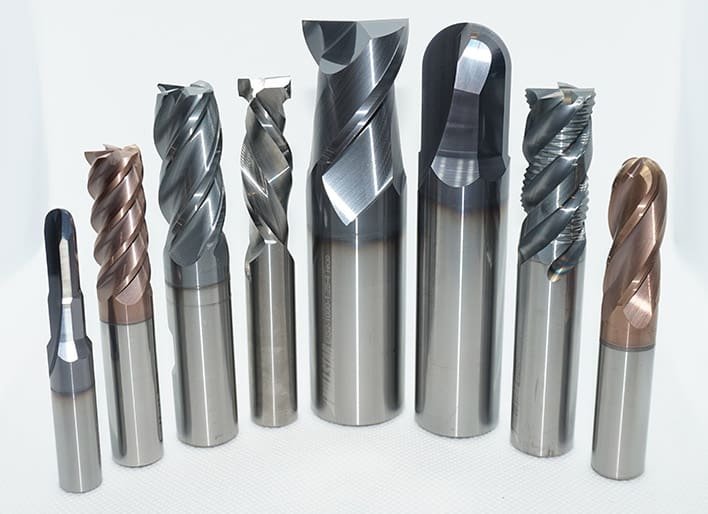Lathe tools are integral instruments in the realm of machining, specifically designed to shape and form materials by rotating the workpiece against a stationary cutting tool. These tools stand out due to their precision and efficiency in turning operations, making them indispensable in both CNC (Computer Numerical Control) and manual machining processes. Unlike other cutting tools, lathe tools are uniquely engineered to handle the stresses and demands of rotational cutting, providing superior control over the material removal process.

The primary function of lathe tools is to perform turning operations, essential for creating cylindrical parts, such as shafts, bolts, and pulleys. These tools come in various shapes and sizes, each tailored for specific tasks like facing, threading, boring, and parting. The versatility of lathe tools allows machinists to achieve a high degree of accuracy and surface finish, which is crucial in industries ranging from automotive to aerospace, and even in the production of delicate medical devices.
One of the distinguishing features of lathe tools is their ability to produce consistent and repeatable results. This is particularly important in mass production environments where maintaining uniformity across numerous parts is critical. Moreover, lathe tools are designed to withstand the rigors of high-speed machining, which enhances productivity and reduces downtime. The robustness and durability of these tools are essential for ensuring long-term operational efficiency.
In various manufacturing sectors, the importance of lathe tools cannot be overstated. Their role extends beyond mere cutting; they are pivotal in achieving the precise dimensions and tolerances required in modern manufacturing. The continuous advancement in lathe tool materials and coatings has further enhanced their performance, enabling machinists to tackle more challenging materials and complex geometries with ease.
In summary, lathe tools are fundamental to the machining industry, providing the necessary capabilities for efficient and precise material shaping. Their unique design and functionality distinguish them from other cutting tools, underscoring their essential role in diverse manufacturing applications.
Types of Lathe Tools
In the realm of machining, understanding the various types of lathe tools is crucial for achieving precision and efficiency. Lathe tools can be broadly categorized based on their functionality, material, and specific applications. This section will delve into these categories, providing a detailed overview of each type.
Tool Holders: Tool holders are essential in securing the cutting tools in place. Among the most common are turret, gang, and capstan tool holders. Turret holders allow for quick tool changes, boosting productivity, especially in complex operations. Gang tool holders, on the other hand, are arranged in a linear fashion, making them ideal for operations that require multiple tools in quick succession. Capstan tool holders are often used in repetitive production tasks, offering ease of use and efficiency.
Inserts: Inserts are replaceable cutting edges that come in various shapes and sizes. Turning inserts are primarily used for removing material from the outer surface of a workpiece. Facing inserts are designed to cut the end surface of a workpiece, ensuring a flat finish. Threading inserts are specialized for cutting threads into a workpiece, providing precision and consistency.
Cutting Tools by Material: The material of the cutting tool significantly impacts its performance and durability. High-speed steel (HSS) tools are known for their versatility and toughness, making them suitable for a wide range of applications. Carbide tools, however, offer superior hardness and wear resistance, making them ideal for high-speed operations and cutting harder materials.
Specialty Tools: Specialty tools are designed for specific machining operations. Grooving tools create narrow channels in a workpiece, essential for components that require specific shapes or features. Parting tools are used to cut off a portion of the workpiece, often used in the final stages of production. Knurling tools create textured surfaces on a workpiece, enhancing grip and aesthetic appeal.
Each type of lathe tool serves a unique purpose, and selecting the right tool for the job is vital for achieving optimal results in machining operations. Understanding these tools’ specific applications and material properties can significantly enhance both the quality and efficiency of the work performed.
Material Considerations for Lathe Tools
When choosing lathe tools for machining tasks, the material of the tool itself plays a critical role in determining performance, durability, and the overall quality of the finished product. Different materials are used to manufacture lathe tools, each with its own unique properties and suitability for various applications. The most commonly used materials include high-speed steel (HSS), carbide, ceramics, and diamond tools.
High-speed steel (HSS) is a popular choice for lathe tools due to its excellent toughness and wear resistance. HSS tools are versatile and can be used for general-purpose machining of both ferrous and non-ferrous metals. They are particularly effective when working with softer metals and plastics, where high cutting speeds are not essential. HSS tools are also relatively easy to sharpen, making them a cost-effective option for many machinists.
Carbide lathe tools, on the other hand, are known for their superior hardness and ability to maintain a sharp cutting edge at high temperatures. This makes them ideal for high-speed machining and for cutting harder materials like stainless steel, cast iron, and high-temperature alloys. Carbide tools are more brittle than HSS, so they require careful handling to avoid chipping or breaking. However, their longevity and performance make them a preferred choice for many demanding applications.
Ceramic lathe tools are another excellent option, especially for high-speed machining operations. They offer exceptional hardness and thermal stability, which allows them to maintain their cutting edge even at extremely high temperatures. Ceramics are particularly effective for machining hard and abrasive materials, such as hardened steels and superalloys. However, similar to carbide, ceramic tools are brittle and require careful usage.
Diamond tools represent the pinnacle of cutting tool materials, providing unmatched hardness and wear resistance. They are primarily used for ultra-precision machining of non-ferrous materials, composites, and highly abrasive materials. Diamond tools deliver superior surface finishes and dimensional accuracy, making them indispensable for applications requiring high precision, such as in the aerospace and semiconductor industries. However, they are not suitable for ferrous materials due to the chemical reaction between diamond and iron at high temperatures.
Selecting the appropriate material for lathe tools involves considering the workpiece material and the specific machining requirements. By understanding the properties and advantages of HSS, carbide, ceramics, and diamond tools, machinists can optimize their tool selection to achieve the best possible performance and longevity.
Tool Holders and Accessories for Lathe Tools
In the realm of machining, tool holders play a pivotal role in determining the precision and efficiency of lathe operations. Different types of tool holders are designed to secure lathe tools, each serving a unique function to enhance machining capabilities. Collet chucks, for example, are known for their high precision and strong grip, making them indispensable for tasks requiring tight tolerances. They are particularly useful in holding small diameter tools and workpieces firmly.
Another important type of tool holder is the turret tool post, which allows for the rapid interchange of tools. This versatility is crucial in complex machining tasks, where multiple tools are required sequentially. By reducing the time spent on changing tools, turret tool posts significantly enhance productivity. Similarly, quick-change tool holders offer the advantage of swiftly replacing lathe tools without the need for meticulous realignment, thereby minimizing downtime and maintaining machining accuracy.
In addition to tool holders, a range of accessories is essential for optimizing lathe operations. Coolant systems, for instance, play a vital role in maintaining the temperature of both the tool and the workpiece, thereby preventing overheating and reducing wear. Effective chip management solutions are also critical; they ensure that chips are efficiently removed from the workspace, preventing damage to the tool and the workpiece.
Tool monitoring devices are another valuable accessory, providing real-time data on tool conditions. These devices can detect issues such as tool wear or breakage, allowing for timely interventions that prevent costly downtime and ensure consistent quality. By integrating these accessories into lathe operations, machinists can achieve higher levels of efficiency and precision.
Overall, the right combination of tool holders and accessories is fundamental to the success of machining operations. By carefully selecting and utilizing these components, machinists can enhance the performance of lathe tools, ensuring precise and efficient manufacturing processes.
Selecting the Right Lathe Tool
Choosing the appropriate lathe tool is crucial for achieving optimal performance in machining processes. Various factors must be considered to ensure precision and efficiency. One primary consideration is the material type. Different materials, such as metals, plastics, and composites, require specific lathe tools tailored to their unique properties. The hardness and machinability of the material also play a significant role; harder materials generally necessitate more robust and durable tools.
Another critical aspect is the desired surface finish. For applications demanding a high-quality finish, selecting a lathe tool with fine-grain carbide or ceramic tips can be advantageous. Dimensional accuracy should also be taken into account, as it directly influences the end-product’s specifications and tolerances. Achieving the correct dimensions often requires tools with precise geometries and minimal wear resistance.
Cutting speed, feed rate, and depth of cut are essential parameters that influence tool selection. The cutting speed determines how quickly the tool moves across the material, affecting the overall machining time and heat generation. A higher cutting speed can increase productivity but may also lead to rapid tool wear. Feed rate, the speed at which the workpiece advances, impacts both the surface finish and tool life. A balanced feed rate ensures a smooth finish while preventing excessive tool strain. Depth of cut, the thickness of the material removed in one pass, should be optimized to avoid tool overload and ensure efficient material removal.
Tool geometry, including rake angle, clearance angle, and cutting edge preparation, is paramount in lathe tool performance. The rake angle, which influences chip formation and flow, should be chosen based on the material’s properties. A positive rake angle is typically preferred for softer materials, while a negative rake angle is suited for harder substrates. The clearance angle prevents the tool from rubbing against the workpiece, reducing friction and heat. Proper cutting edge preparation, such as honing and coating, can enhance tool durability and performance.
By carefully considering these factors, machinists can select the most appropriate lathe tools, ensuring optimal results in their machining operations.
Applications of Lathe Tools
Lathe tools are fundamental in executing a variety of turning operations, each designed to achieve specific machining goals. Among the most common turning operations is facing, which involves cutting a flat surface perpendicular to the workpiece’s axis. This operation is typically the first step in machining and is essential for preparing a smooth, flat surface.
Contour turning, another critical operation, allows for the creation of complex shapes by moving both the cutting tool and workpiece along predetermined paths. This technique is vital for producing intricate components that require precision and accuracy. Taper turning, on the other hand, is employed to cut a conical shape on the workpiece, and is often used in applications where parts need to fit together with a slight angle, such as in pipe fittings and tool holders.
Threading is also a significant application of lathe tools, enabling the creation of screw threads on the exterior or interior of cylindrical surfaces. This operation is indispensable in producing fasteners and threaded components, which are ubiquitous in various mechanical assemblies.
Different industries leverage these turning operations to achieve specific objectives. In the automotive sector, for example, lathe tools are used to manufacture engine components, drive shafts, and transmission parts, where precision and durability are paramount. The aerospace industry relies on high-precision lathe tools for crafting turbine blades, landing gear components, and structural supports, ensuring both safety and performance in challenging environments.
The medical industry also benefits significantly from the use of lathe tools. Surgical instruments, orthopedic implants, and dental components are often manufactured using specialized turning operations. These tools enable the production of complex, high-precision parts that meet stringent regulatory standards, ensuring their reliability and effectiveness in medical procedures.
In summary, lathe tools are indispensable across various industries, providing the precision and versatility required to produce high-quality components. From facing and contour turning to taper turning and threading, these tools play a crucial role in modern manufacturing practices. (CNC Tune for Instagram)
Advantages of Using Lathe Tools
Lathe tools are indispensable in various industrial and manufacturing settings due to their numerous advantages. One of the most significant benefits of using lathe tools is their unparalleled precision and accuracy. These tools are designed to achieve tight tolerances and fine surface finishes, ensuring that the final product meets stringent quality standards. This level of precision is particularly important in industries where even the slightest deviation can lead to significant issues, such as aerospace, automotive, and medical device manufacturing.
Another key advantage of lathe tools is their versatility. A single lathe machine can perform a wide range of operations, including turning, facing, threading, drilling, and boring, among others. This versatility reduces the need for multiple specialized machines, thereby minimizing setup changes and streamlining the production process. The ability to switch between different operations swiftly enhances the overall efficiency and productivity of the manufacturing process.
Moreover, lathe tools contribute to substantial time and cost savings. The automation and precision offered by modern lathe machines reduce the reliance on manual labor, thereby decreasing the likelihood of human error. This not only improves the consistency and quality of the output but also lowers production costs. Additionally, the high-speed operation of lathe tools significantly cuts down on machining time, enabling faster turnaround and increased throughput.
Lathe tools also offer a high degree of customization and flexibility. They can be programmed to create complex shapes and intricate designs with ease, catering to specific requirements and bespoke projects. This adaptability makes lathe tools a preferred choice for both mass production and specialized, small-batch manufacturing.
In summary, the precision, versatility, efficiency, and cost-effectiveness of lathe tools make them an essential asset in modern manufacturing. Their ability to perform multiple functions with minimal setup changes, coupled with their high-speed operation and reduced error rates, ensures that they remain a cornerstone in achieving high-quality and economically viable production outcomes.
Maintenance and Care of Lathe Tools
Proper maintenance and care of lathe tools are paramount to ensure their longevity and optimal performance. The first step in preserving these essential instruments involves regular cleaning. It is crucial to remove any debris, metal shavings, and residue after each use. This can be effectively achieved using a soft brush and a gentle solvent. Avoid using harsh chemicals as they can corrode the tool material, causing premature wear.
Storing lathe tools correctly is equally important. Tools should be kept in a dry, controlled environment to prevent rust and corrosion. Utilizing storage solutions such as toolboxes with padded compartments or magnetic strips can help in organizing and protecting the tools from physical damage. Additionally, applying a light coat of oil to the metal parts before storage can provide an extra layer of protection against moisture.
Regular inspection of lathe tools is necessary to identify any signs of wear or damage. Pay close attention to the cutting edges, as nicks or dullness can significantly affect performance. If damage is detected, the tools should be reconditioned promptly. Reconditioning processes such as sharpening and regrinding are essential to restore the tool’s cutting efficiency. Sharpening can be done using a bench grinder or specialized sharpening equipment, ensuring that the tool’s geometry is maintained.
Regrinding, on the other hand, may be required for more severely worn tools. This process removes a thin layer of material to reveal a fresh, sharp edge. It is advisable to follow the manufacturer’s guidelines for regrinding to ensure the tool retains its original specifications. In some cases, professional reconditioning services may be necessary, especially for high-precision tools.
In conclusion, diligent maintenance practices, including cleaning, proper storage, regular inspection, and timely reconditioning, are essential for the optimal performance and longevity of lathe tools. By following these guidelines, users can ensure their lathe tools remain sharp, efficient, and reliable for various machining tasks.
Common Issues and Troubleshooting
Lathe tools are indispensable in precision machining, yet they are not immune to wear and breakage. Understanding the common issues that arise with lathe tools can significantly improve productivity and extend tool life. Tool wear and breakage often stem from improper usage, incorrect feed rates, or inadequate maintenance. To prevent these issues, it is essential to regularly inspect tools for signs of wear and ensure they are used within the manufacturer’s specified parameters.
One prevalent issue is poor surface finish, which can result from dull cutting edges, incorrect cutting speeds, or improper tool alignment. To address this, operators should frequently check and replace worn-out lathe tools and calibrate the machine to the correct settings. Ensuring the workpiece is securely clamped can also mitigate surface finish problems. Moreover, using cutting fluids can enhance lubrication and cooling, leading to smoother surfaces.
Chatter and vibration are other common challenges in machining with lathe tools. These issues can affect the accuracy and quality of the workpiece. Minimizing chatter involves selecting the appropriate feed rate and cutting speed, as well as ensuring the rigidity of both the machine and the workpiece setup. Additionally, using sharp and well-maintained tools can reduce vibration during operations.
Preventive maintenance is crucial in troubleshooting lathe tool issues. Regularly cleaning the machine, checking for alignment, and ensuring the tools are sharp can preempt many common problems. Operators should also be trained in proper tool handling and machine operation techniques, as human error is a significant factor in tool wear and breakage.
By adhering to these best practices, machinists can maximize the efficiency and lifespan of their lathe tools, leading to higher quality outputs and reduced downtime. Understanding the common pitfalls and implementing effective troubleshooting measures will ensure smooth and efficient machining processes.
Innovations and Trends in Lathe Tools
Recent advancements in lathe tools have revolutionized the machining industry, offering enhanced performance and longevity. One significant innovation is in the materials and coatings used in lathe tools. Modern manufacturing processes now employ advanced materials such as carbide, ceramic, and polycrystalline diamond (PCD). These materials provide exceptional hardness and heat resistance, drastically reducing tool wear and improving cutting efficiency.
The use of advanced coatings, such as titanium nitride (TiN) and aluminum titanium nitride (AlTiN), further extends tool life by providing a protective layer that reduces friction and prevents oxidation. These coatings improve the thermal stability of lathe tools, enabling higher cutting speeds and feed rates, which translates to increased productivity and cost efficiency.
In addition to material innovations, the integration of smart tooling and Industry 4.0 concepts is reshaping the landscape of lathe tool technology. The incorporation of the Internet of Things (IoT) and data analytics into lathe tool design and monitoring allows for real-time data collection and analysis. This capability enables predictive maintenance, reducing downtime and preventing unexpected tool failures. Sensors embedded in lathe tools can monitor parameters such as temperature, vibration, and wear, providing valuable insights into tool performance and enabling more informed decision-making.
The advent of smart tooling also facilitates adaptive machining processes. By leveraging data analytics, lathe tools can adjust their cutting parameters dynamically to optimize performance and enhance precision. This adaptability is particularly beneficial in complex machining operations, where maintaining tight tolerances is crucial.
Looking ahead, the future of lathe tool technology appears promising. Emerging trends include the development of even more advanced materials and coatings, as well as the continued integration of smart technologies. Researchers are exploring the potential of nanomaterials and surface treatments to further enhance tool performance. Additionally, advancements in artificial intelligence and machine learning are expected to play a pivotal role in the evolution of lathe tools, enabling even greater levels of automation and efficiency in machining practices.
Safety Considerations When Using Lathe Tools
Ensuring safety while utilizing lathe tools is paramount for both novice and experienced operators. Proper adherence to safety guidelines not only prevents accidents but also maximizes the efficiency of the lathe machine. One of the fundamental aspects of lathe tool safety is the use of appropriate personal protective equipment (PPE). Operators should always wear safety glasses or face shields to protect themselves from flying debris. Additionally, hearing protection is advisable in environments where noise levels are high due to prolonged lathe operation.
When handling lathe tools, it is crucial to maintain a clutter-free workspace. Loose objects and tools should be kept away from the machine to prevent them from becoming hazards. Operators must also ensure that workpieces are securely fastened before commencing any operation, as unsecured materials can cause significant injury or damage. Proper attire, including fitted clothing and the avoidance of jewelry, is essential to prevent entanglement with moving parts.
Operating a CNC lathe involves a series of methodical steps to ensure safety. Before starting the machine, operators should conduct a thorough inspection, checking for any wear or damage to the lathe tools and machine components. It is essential to verify that all guards and safety devices are in place and functioning correctly. Moreover, understanding the control panel and emergency stop functions is vital. Operators should be trained to recognize and respond to any irregular sounds or vibrations during the operation, as these can be indicators of potential malfunctions.
In the event of an emergency or tool failure, immediate and appropriate action is required. Operators must know the location of emergency stops and how to use them effectively. Establishing and rehearsing emergency procedures, including first aid measures and the shutdown of machinery, can significantly reduce the impact of accidents. Regular safety drills and continuous education on the latest safety protocols are recommended to keep safety practices current and effective.
Future Outlook
In conclusion, lathe tools remain indispensable in the machining and manufacturing sectors, offering unparalleled precision and efficiency. Throughout this guide, we have delved into various types of lathe tools, such as cutting tools, boring bars, and threading tools, each serving unique functions to cater to specific machining needs. Understanding the applications of these tools is crucial for achieving optimal results, whether in metalworking, woodworking, or plastic fabrication. The benefits of using high-quality lathe tools include enhanced accuracy, improved surface finish, and extended tool life, all of which contribute to increased productivity and cost-effectiveness in industrial operations.
Looking ahead, the future of lathe tools is poised for significant advancements driven by technological innovations. Developments in materials science are likely to lead to the creation of more durable and efficient tool materials, such as advanced ceramics and carbide composites. Additionally, the integration of smart technology and automation is expected to revolutionize lathe operations. Smart lathe tools equipped with sensors and IoT capabilities will enable real-time monitoring and predictive maintenance, minimizing downtime and reducing operational costs.
Furthermore, the adoption of computer-aided design (CAD) and computer-aided manufacturing (CAM) technologies will continue to streamline the machining process, allowing for more complex and precise designs to be realized with greater ease. As industries increasingly prioritize sustainability, the demand for eco-friendly and energy-efficient lathe tools will rise, driving manufacturers to innovate in this area.
Overall, the evolution of lathe tools will be characterized by enhanced performance, increased automation, and a focus on sustainability. By staying abreast of these advancements, professionals in the machining and manufacturing fields can ensure they remain competitive and capable of meeting the ever-evolving demands of their industries.
Additional Resources and References
For those seeking to deepen their understanding of lathe tools and their applications, a variety of resources are available. Comprehensive books such as “Machine Shop Essentials” by Frank Marlow and “The Lathe Book” by Ernie Conover offer detailed insights into the functionality and utilization of lathe tools. These texts are invaluable for both beginners and seasoned machinists, providing a strong foundational knowledge and advanced techniques.
In addition to books, several scholarly articles and industry publications can further enhance your expertise. Journals like “Machining Science and Technology” and “Journal of Manufacturing Processes” frequently feature research on the latest advancements in lathe tooling. Websites such as Machinist’s Workshop and Practical Machinist also provide forums and articles where professionals discuss best practices, innovative methods, and troubleshooting tips.
For more hands-on learning, various training and education opportunities are available. Many technical colleges and vocational schools offer courses in CNC machining and lathe operations. Programs such as the National Institute for Metalworking Skills (NIMS) certifications are particularly beneficial, as they are widely recognized in the industry and cover a broad spectrum of lathe tooling competencies.
Workshops and seminars hosted by organizations like the Society of Manufacturing Engineers (SME) can also be beneficial. These events often feature expert-led sessions that delve into specific aspects of lathe tool usage, providing practical knowledge that can be immediately applied in a professional setting.
Finally, online platforms like Coursera, Udemy, and LinkedIn Learning offer flexible learning options. Courses on these platforms range from introductory to advanced levels, allowing you to progress at your own pace. Engaging in continuous education and staying updated with the latest trends and technologies will ensure you remain proficient in the ever-evolving field of lathe tooling and CNC machining.






Leave a Comment